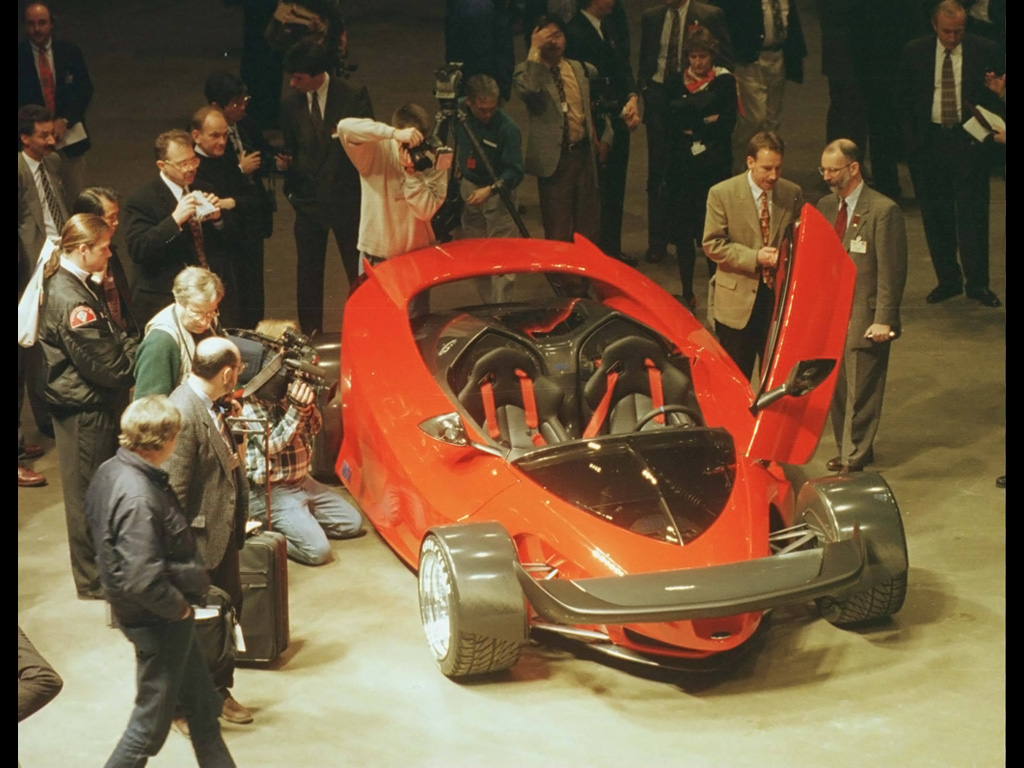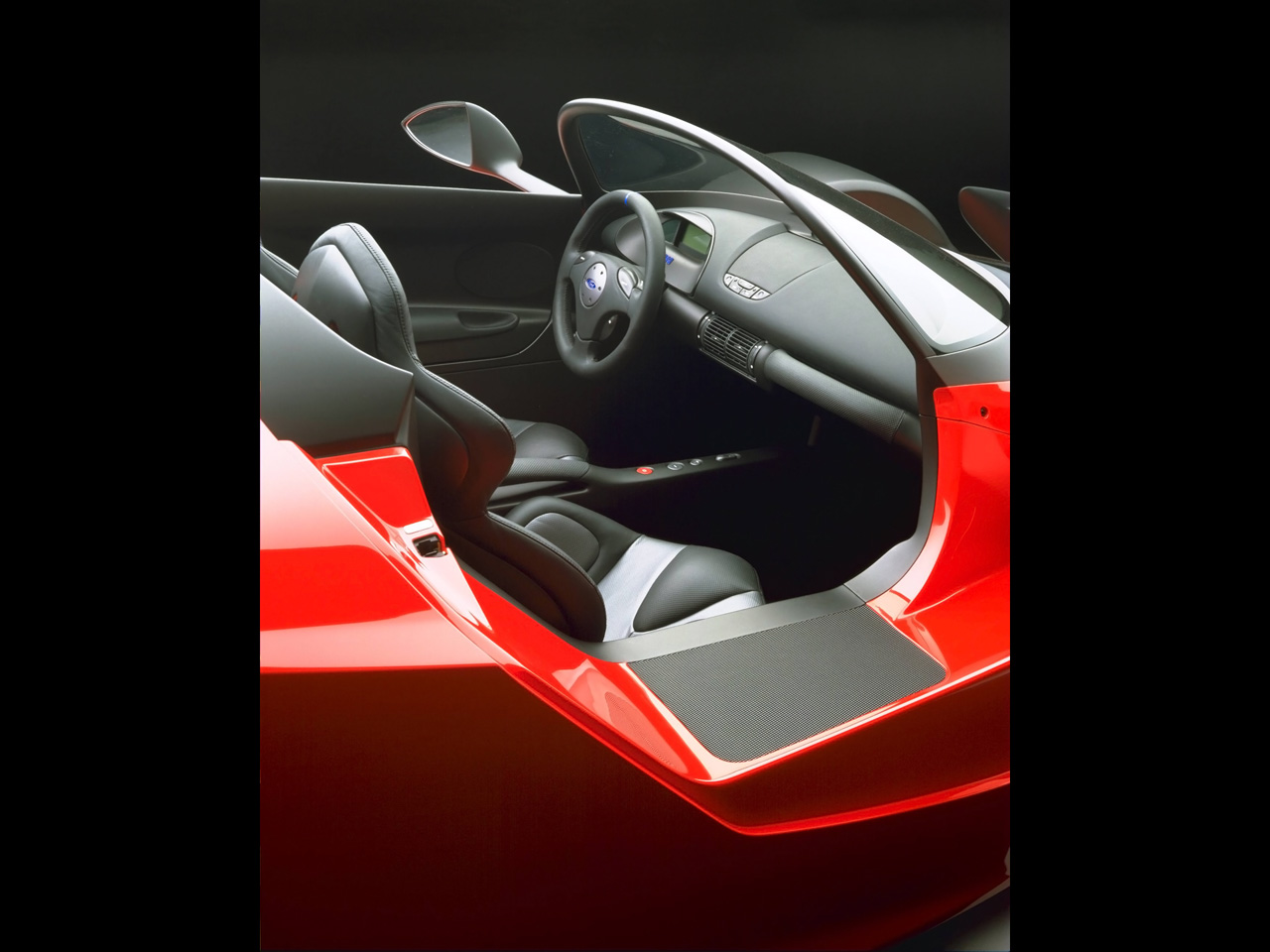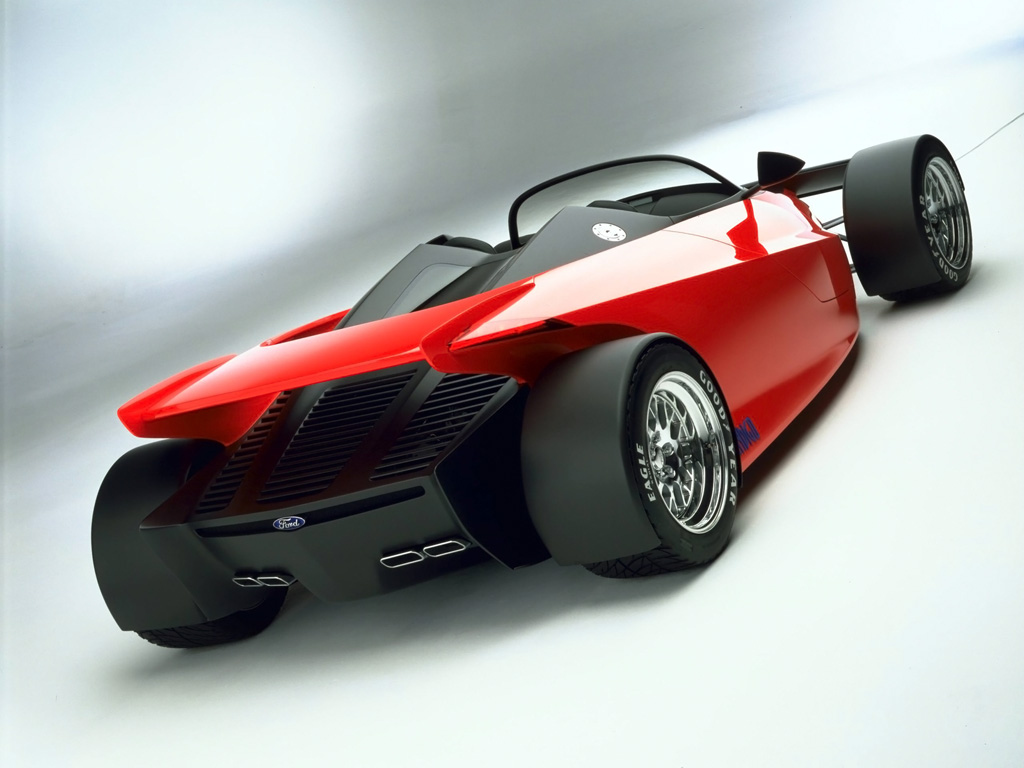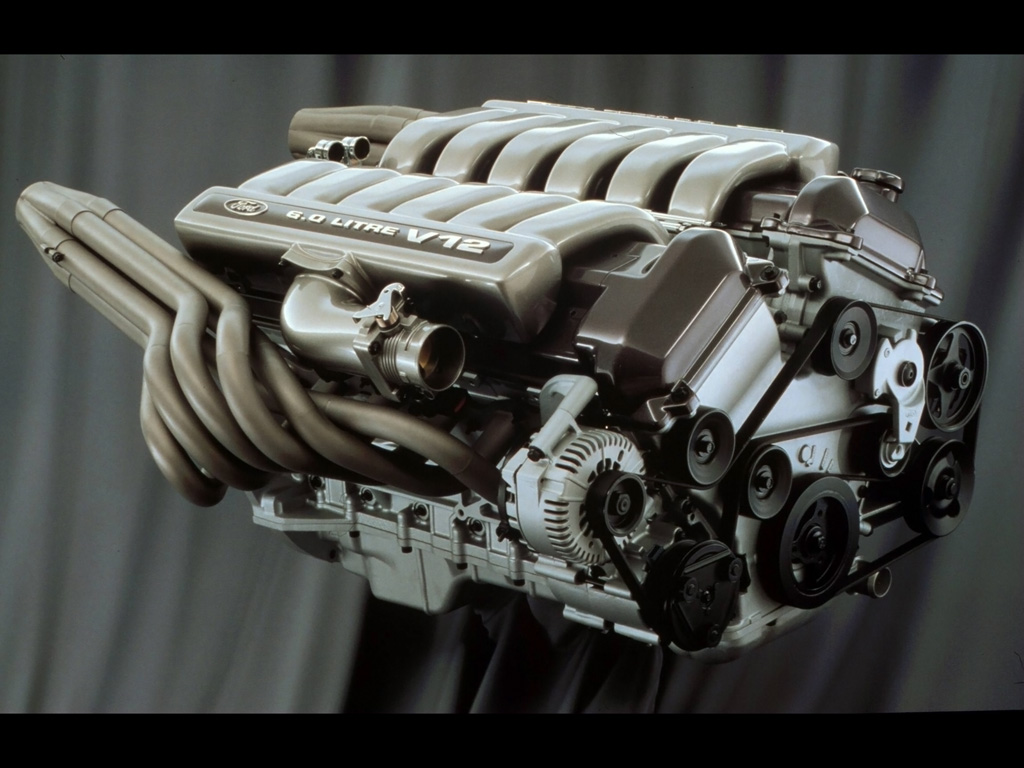1996 Ford Indigo Concept
|
Price |
-- |
Production |
-- | ||
|
Engine |
6 liter V12 |
Weight |
-- | ||
|
Aspiration |
-- |
Torque |
405 lb-ft @ 5250 rpm | ||
|
HP |
435 hp @ 6100 rpm |
HP/Weight |
-- | ||
|
HP/Liter |
72.5 hp per liter |
1/4 mile |
-- | ||
|
0-62 mph |
-- |
Top Speed |
-- |
(from Ford Press Release) Race track design and technology drives the Ford Indigo concept sports carThe Ford Indigo is a high performance, V-12 concept sports car that takes its design and technology inspiration from some of the fastest cars in the world, Indy car and Formula 1 racing cars.
With over 260 Indy car triumphs -- including 17 Indianapolis 500
wins -- plus more than 200 Grand Prix victories and 13 constructor's
world championships in Formula 1, Ford is the most successful
manufacturer in the history of Indy car and Formula 1 motor racing.
The Indigo combines Ford and primarily Indy car technologies and
practices in the areas of materials, construction techniques,
powertrain and aerodynamics to create a new dimension in driving
excitement by bringing the thrill of the race track to the street.
But the Indigo is much more than just an exciting new show car. Two
versions of the car have been produced: a non-driveable "Show" car
that will tour the major international auto shows in 1996; and a
fully-functional, engineered and driveable model, nicknamed the "Go"
car by the Indigo team.
Monocoque chassis technology
The "Go" derivative of the Indigo features a monocoque chassis which
was designed and manufactured using current Indy car build
practices. The chassis was developed in conjunction with Reynard
Racing Cars, the UK-based specialist supplier and winner of the 1995
CART/PPG Indy Car World Series Constructor's Championship.
The chassis consists of a specially designed central tub formed of a
lightweight carbon fiber, aluminum honeycomb composite material.
This monocoque chassis differs from a conventional chassis in that
it is a one-piece, highly-efficient racing-inspired structure that
both forms the Indigo's interior and has the front suspension and
running gear attached to it.
The rigid construction of the chassis cocoons the driver and
passenger in a cell-like structure, with the wide air intake ducts
located in the deep rocker panels providing an exceptional level of
side-impact protection. Many of the composite components are also
being studied to examine their structural properties under stress.
Indy car suspension
The front suspension -- Indy car-type double wishbones with pushrods
operating inboard coil-over shock absorbers -- is fitted directly to
the chassis tub. The rear suspension also features double wishbones
with pushrods and inboard coil-over shock absorbers and locates
directly to the transaxle.
Both front and rear suspensions are formed from the same high
strength, aero section chrome moly steel tubing that Reynard uses on
its Indy cars. The rear suspension arms and geometry are virtually
identical to those of an Indy car, while the Indigo's two-passenger
tub required the front suspension arms be shorter and have a
slightly different geometry than that found on the racing cars.
And while Indy cars often require as little as one inch of
suspension travel to achieve maximum handling, the Indigo has
considerably more travel to cope with the demands of driving on the
street.
No rubber or neoprene bushings are used in the suspension system;
pivot points are all rosejoints or spherical bearings. Steering is
by a modified Taurus rack-and-pinion fitted with custom-designed
electric power-assist.
All-new V-12 engine
The Indigo is equipped with an all-new V-12 engine developed by the
Core & Advanced Powertrain Engineering team within Ford's Advanced
Vehicle Technology group, the organization responsible for
generating new technologies for future production vehicles.
The V-12 is a 6.0-liter, four-cam, 48-valve, 60 degree engine which
currently has an output of 435 hp (SAE net) at 6,100 rpm and 405
lbs-ft torque at 5,250 rpm. The engine is still undergoing
development testing, but these are the expected final
horsepower/torque levels when the engine is tuned to meet current
and future projected emissions levels running through catalysts
fitted to the stainless steel exhaust system.
As powerful as the engine is, one of its main features is the
abundance of low-end torque. Approximately three-quarters of the
V-12's maximum torque is available at just 1,000 rpm. The engine is
also notable for its fuel efficiency and is expected to achieve over
28 mpg in normal highway driving.
The V-12 represents not only a very powerful engine but also a
breakthrough in development cost and timing. This is largely the
result of the unit's clever use of existing Ford engine components.
The basis for the V-12 is the current production 3.0-liter Duratec
V-6 engine used in the 1996 Ford Taurus and Mercury Sable. It uses
the same bore and stroke dimensions (89.0 mm x 79.5 mm) as the
Duratec, and also shares its pistons, rings, rods, valves, valve
seals, valve springs and retainers.
However, the V-12 block and cylinder heads are all-new, cast from
356-T6 aluminum alloy by Cosworth in Great Britain. The cylinder
heads retain the Duratec's combustion chamber and exhaust port
design. The intake ports incorporate a new, "tumble-port" design
that creates low-rpm, intake-charge turbulence without the need for
throttling one of each pair of intake valves.
Unlike the Duratec, the V-12 block is not a girdled design. Instead,
it is deep-skirted for extra torsional stiffness. (The V-12
approximates the torsional rigidity of the Duratec V-6 despite its
extra length.) The crankshaft is formed using an all-new casting
process called "electro-slag casting", which is claimed to result in
crankshafts that are 10 percent stronger than forged units.
Several other revisions were made to the Duratec design to adapt
components to the new V-12 configuration. These include a new water
pump, extra internal cooling passages and oil-spray jets that cool
the underside of the pistons to add an extra measure of thermal
control for sustained high-rpm driving, such as autobahn runs.
Dual spray fuel injectors -- single injectors for each cylinder that
spray both intake ports at the same time -- are used in the V-12 and
are similar to the components utilized in the last production Taurus
SHO V-6 engine. Fuel is fed to the engine via pumps housed in the
racing-style, bladder fuel cell. A dry sump system is also fitted to
the engine to ensure consistent oil flow through the block.
Cooling is provided by twin 14 x 14-inch radiators, one each side of
the passenger compartment, with air being force-fed through the
large side air scoops behind the front tires. Additional cooling in
low-speed driving is available from electric fans.
The V-12 is perfectly balanced to minimize noise, vibration and
harshness (NVH). Included in its second-generation onboard
diagnostic system (OBD II), is a flame ionization sensor which
detects in-cylinder misfire.
The engine is also bolted rigidly to the chassis' passenger
compartment rear bulkhead and also acts as a load-bearing member --
standard practice on Indy cars.
The development of the V-12 began prior to the Indigo project and
took just 18 months from inception until the first engine was tested
on a dyno in September 1995.
Racing-derived transaxle
The Indigo utilizes a longitudinally-mounted, modified Reynard Indy
car transaxle. This unit has six forward gears and a reverse, and
features a racing-style, manually-operated carbon clutch. The
forward gears are selected sequentially by a an electronic,
hydraulic shifter.
Buttons on the front of the Nardi steering wheel signal the system
to upshift, while alternate buttons on the back of the wheel control
downshifts. The clutch must be used on all shifts.
Massive wheels and tires The V-12's power reaches the ground via the
Indy car-style Fikse three-piece modular wheels. Wheel sizes are
11.5 x 17-inch front and 12.5 x 18-inch rear, and have a five-bolt
pattern instead of the more usual racing single center-lock design.
(The five-bolt pattern is considered to be safer for street use as
wheel-to-hub positioning is more consistent when the wheels are
installed by someone other than a fully-trained pit crewman.)
The massive wheels are wrapped in special hand-cut Goodyear Eagle
high performance racing tires, correlating to street-tire sizes of
335/30ZR-17 on the front and 355/35ZR-18 at the rear.
Brembo 335 x 20 mm front and 355 x 20 mm rear disc brakes help to
stop the Indigo in an estimated 100 feet in computer simulated 60 to
0 mph testing.
Exhilarating yet functional design
Functionality and the racing car theme were strong influences in the
design of the body. In keeping with Indy car practice, the Indigo's
exterior body panels consist of composite carbon fiber and aluminum
honeycomb. Just as on racing cars, some of the panels are retained
in their black composite carbon fiber finish to contrast with the
bright red of the remaining body panels.
The scissor-style doors are hinged at the front and are raised by
lifting them forward and slightly out from the body, allowing the
driver and passenger to step down into the car.
The car has undergone wind tunnel testing. The results show that
enough downforce is being generated by the wings, underbody diffuser
and overall body shape to enable the Indigo to corner at a projected
lateral acceleration of 1.2g.
The ability to see the road clearly at night or in low light
conditions is an essential safety feature for any car. The Indigo
has an advanced lighting system developed with Philips Lighting. It
uses a high-intensity discharge (HID) light source, with light piped
through fiber optics to the main headlamps which are uniquely
situated in the front section of the door rear view mirrors.
Additional HID fog lights and turn signals are located in the front
wing, which also acts as a bumper. The rear taillights, consisting
of small projector lights, are located at the outboard edges of the
rear wing.
Interior continues Indy car theme
The interior of the Indigo is geared towards creating the racing car
experience for the road. It consists of a black carbon fiber finish
with some elements trimmed in black leather.
An electronic, Indy car-style instrument cluster features gauges for
engine rpm, gear position, a speedometer and engine temperature. A
premium stereo radio with a mini disc changer are positioned in the
center of the instrument panel.
The leather-trimmed, power-operated, deep bucket seats jointly
designed with Johnson Controls include four-point harnesses, with
the lap belts integrated into the seat base. Usually, a four-point
racing belt system would comprise of four separate belts which lock
into a central buckle.
However, this semi-integrated restraint system is divided into a
left and right side belt -- each side containing two of the four
belts -- with just one connection into the buckle for greater ease
of use.
The interior also has provision for the fitment of driver and
passenger airbags.
The building of the Indigo -- which took just six months to complete
from the first computer design rendering to a driveable car -- was
primarily the responsibility of Ford's Advanced Design team and
Advanced Vehicle Technology group, suppliers Reynard Racing Cars and
ASC, with Ford's New Concepts Organization overseeing the management
of the project. Many other Ford suppliers were also involved in the
construction of the car.
The New Concepts Organization is a group within Ford Product
Development that fosters fresh ideas on niche and "breakthrough"
vehicle concepts and also assists in developing low-cost vehicle
designs and production processes.



